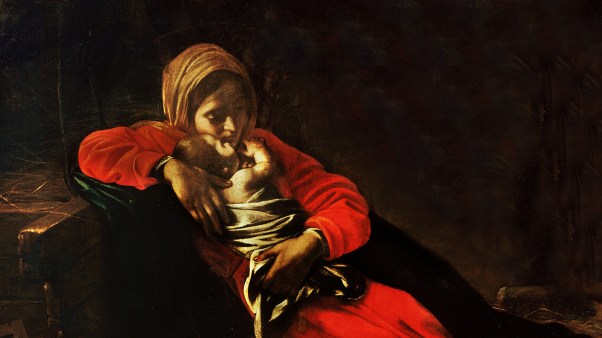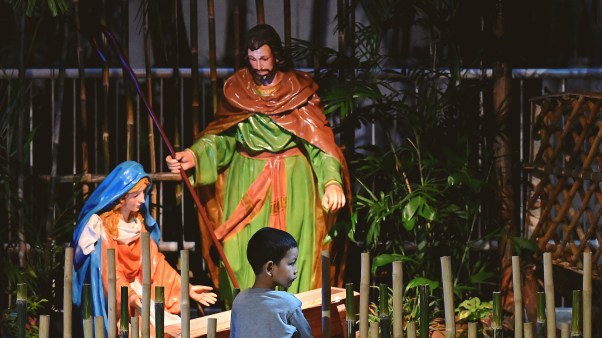First of Two Parts
That the Easter faith in the Resurrection of Christ is the core of Christianity can hardly be denied. Whether that conviction is rooted in myth, in hallucination, or in history has often been debated. Some have maintained that the Resurrection of Christ is a myth patterned after the prototypes of dying and rising fertility gods. Others argue that subjective visions of the risen Christ were sufficient to convince the disciples that their leader was not dead. Even those who do not doubt the historicity of Christ’s life and death differ as to how the Resurrection may be viewed historically. Let us examine the evidences for these alternatives.
I. Easter As Myth
A. Dying and Rising Fertility Gods
John H. Randall, emeritus professor of philosophy at Columbia University, has asserted: “Christianity, at the hands of Paul, became a mystical system of redemption, much like the cult of Isis, and the other sacramental or mystery religions of the day” (Hellenistic Ways of Deliverance and the Making of the Christian Synthesis, 1970, p. 154). Hugh Schonfield in Those Incredible Christians (1968, p. xii) has declared: “The revelations of Frazer in The Golden Bough had not got through to the masses.… Christians remained related under the skin to the devotees of Adonis and Osiris, Dionysus and Mithras.”
The theory that there was a widespread worship of a dying and rising fertility god—Tammuz in Mesopotamia, Adonis in Syria, Attis in Asia Minor, and Osiris in Egypt—was propounded by Sir James Frazer, who gathered a mass of parallels in part IV of his monumental work The Golden Bough (1906, reprinted in 1961). This view has been adopted by many who little realize its fragile foundations. The explanation of the Christian Resurrection by such a comparative-religions approach has even been reflected in official Soviet propaganda (cf. Paul de Surgy, editor, The Resurrection and Modern Biblical Thought, 1966, pp. 1, 131).
In the 1930s three influential French scholars, M. Goguel, C. Guignebert, and A. Loisy, interpreted Christianity as a syncretistic religion formed under the influence of Hellenistic mystery religions. According to A. Loisy (“The Christian Mystery,” Hibbert Journal, X [1911–12], 51), Christ was “a saviour-god, after the manner of an Osiris, an Attis, a Mithra.… Like Adonis, Osiris, and Attis he had died a violent death, and like them he had returned to life.…
B. Reexamination of the Evidences
A reexamination of the sources used to support the theory of a mythical origin of Christ’s resurrection reveals that the evidences are far from satisfactory and that the parallels are too superficial.
In the case of the Mesopotamian Tammuz (Sumerian Dumuzi), his alleged resurrection by the goddess Inanna-Ishtar had been assumed even though the end of both the Sumerian and the Akkadian texts of the myth of “The Descent of Inanna (Ishtar)” had not been preserved. Professor S. N. Kramer in 1960 published a new poem, “The Death of Dumuzi,” that proves conclusively that instead of rescuing Dumuzi from the Underworld, Inanna sent him there as her substitute (cf. my article, “Tammuz and the Bible,” Journal of Biblical Literature, LXXXIV [1965], 283–90). A line in a fragmentary and obscure text is the only positive evidence that after being sent to the Underworld Dumuzi may have had his sister take his place for half the year (cf. S. N. Kramer, Bulletin of the American Schools of Oriental Research, No. 183 [1966], 31).
Tammuz was identified by later writers with the Phoenician Adonis, the beautiful youth beloved of Aphrodite. According to Jerome, Hadrian desecrated the cave in Bethlehem associated with Jesus’ birth by consecrating it with a shrine of Tammuz-Adonis. Although his cult spread from Byblos to the Greco-Roman world, the worship of Adonis was never important and was restricted to women. P. Lambrechts has shown that there is no trace of a resurrection in the early texts or pictorial representations of Adonis; the four texts that speak of his resurrection are quite late, dating from the second to the fourth centuries A.D. (“La ‘resurrection’ d’Adonis,” in Melanges Isidore Levy, 1955, pp. 207–40). Lambrechts has also shown that Attis, the consort of Cybele, does not appear as a “resurrected” god until after A.D. 150. (“Les Fêtes ‘phrygiennes’ de Cybèle et d’ Attis,” Bulletin de I’Institut Historique Belge de Rome, XXVII [1952], 141–70).
This leaves us with the figure of Osiris as the only god for whom there is clear and early evidence of a “resurrection.” Our most complete version of the myth of his death and dismemberment by Seth and his twofold resuscitation by Isis is to be found in Plutarch, who wrote in the second century A.D. (cf. J. Gwyn Griffiths, Plutarch’s De Iside et Osiride, 1970). His account seems to accord with statements made in the early Egyptian texts. After the New Kingdom (from 1570 B.C. on) even ordinary men aspired to identification with Osiris as one who had triumphed over death.
But it is a cardinal misconception to equate the Egyptian view of the afterlife with the “resurrection” of Hebrew-Christian traditions. In order to achieve immortality the Egyptian had to fulfill three conditions: (1) His body had to be preserved, hence mumification. (2) Nourishment had to be provided either by the actual offering of daily bread and beer, or by the magical depiction of food on the walls of the tomb. (3) Magical spells had to be interred with the dead—Pyramid Texts in the Old Kingdom, Coffin Texts in the Middle Kingdom, and the Book of the Dead in the New Kingdom. Moreover, the Egyptian did not rise from the dead; separate entities of his personality such as his Ba and his Ka continued to hover about his body.
Nor is Osiris, who is always portrayed in a mumified form, an inspiration for the resurrected Christ. As Roland de Vaux has observed:
What is meant of Osiris being “raised to life”? Simply that, thanks to the ministrations of Isis, he is able to lead a life beyond the tomb which is an almost perfect replica of earthly existence. But he will never again come among the living and will reign only over the dead.… This revived god is in reality a “mummy” god [The Bible and the Ancient Near East, 1971, p. 236].
C. Inexact Parallels From Late Sources
What should be evident is that past studies of phenomenological comparisons have inexcusably disregarded the dates and the provenience of their sources when they have attempted to provide prototypes for Christianity. Let me give two examples, Mithra and the taurobolium.
Mithra was the Persian god whose worship became popular among Roman soldiers (his cult was restricted to men) and was to prove a rival to Christianity in the late Roman Empire. Early Zoroastrian texts, such as the Mithra Yasht, cannot serve as the basis of a mystery of Mithra inasmuch as they present a god who watches over cattle and the sanctity of contracts. Later Mithraic evidence in the west is primarily iconographic; there are no long coherent texts.
Those who seek to adduce Mithra as a prototype of the risen Christ ignore the late date for the expansion of Mithraism to the west (cf. M. J. Vermaseren, Mithras, The Secret God, 1963, p. 76). The only dated Mithraic inscriptions from the pre-Christian period are the texts of Antiochus I of Commagene (69–34 B.C.) in eastern Asia Minor. After that there is one text possibly from the first century A.D. from Cappadocia, one from Phrygia dated to A.D. 77–78, and one from Rome dated to Trajan’s reign (A.D. 98–117). All other dated Mithraic inscriptions and monuments belong to the second century (after A.D. 140), the third, and the fourth century A.D. (M. J. Vermaseren, Corpus Inscriptionum et Monumentorum Religionis Mithriacae, 1956).
The taurobolium was a bloody rite associated with the worship of Mithra and of Attis in which a bull was slaughtered on a grating over an initiate in a pit below, drenching him with blood. This has been suggested (e.g., by R. Reitzenstein) as the basis of the Christian’s redemption by blood and Paul’s imagery in Romans 6 of the believer’s death and resurrection. Gunter Wagner in his exhaustive study Pauline Baptism and the Pagan Mysteries (1963) points out how anachronistic such comparisons are:
The taurobolium in the Attis cult is first attested in the time of Antoninus Pius for A.D. 160. As far as we can see at present it only became a personal consecration at the beginning of the third century A.D. The idea of a rebirth through the instrumentality of the taurobolium only emerges in isolated instances towards the end of the fourth century A.D.; it is not originally associated with this blood-bath [p. 266].
Indeed, there is inscriptional evidence from the fourth century A.D. that, far from influencing Christianity, those who used the taurobolium were influenced by Christianity. Bruce Metzger in his important essay “Methodology in the Study of the Mystery Religions and Early Christianity” (Historical and Literary Studies: Pagan, Jewish and Christian (1968), notes:
Thus, for example, one must doubtless interpret the change in the efficacy attributed to the rite of the taurobolium. In competing with Christianity, which promised eternal life to its adherents, the cult of Cybele officially or unofficially raised the efficacy of the blood bath from twenty years to eternity [p. 11].
Another aspect of comparisons between the resurrection of Christ and the mythological mysteries is that the alleged parallels are quite inexact. It is an error, for example, to believe that the initiation into the mysteries of Isis, as described in Apuleius’s The Golden Ass, is comparable to Christianity. For one thing, the hero, Lucius, had to pay a fortune to undergo his initiation. And as Wagner correctly observes: “Isis does not promise the mystes immortality, but only that henceforth he shall live under her protection, and that when at length he goes down to the realm of the dead he shall adore her …” (op. cit., p. 112).
On the other hand, the followers of Dionysus (Bacchus), the god of wine, did believe in immortality. But they did not hope for a resurrection of the body; nor did they base their faith on the reborn Dionysus of the Orphics, but rather on their experience of drunken ecstasy (cf. M. Nilsson, The Dionysiac Mysteries of the Hellenistic and Roman Age, 1957).
In any case, the death and resurrection of these various mythological figures, however attested, always typified the annual death and rebirth of vegetation. This significance cannot be attributed to the death and resurrection of Jesus. A. D. Nock sets forth the most striking contrast between pagan and Christian notions of “resurrection” as follows:
In Christianity everything is made to turn on a dated experience of a historical Person; it can be seen from 1 Cor. 15:3 that the statement of the story early assumed the form of a statement in a Creed. There is nothing in the parallel cases which points to any attempt to give such a basis of historical evidence to belief (Early Gentile Christianity and Its Hellenistic Background, 1964, p. 107).
THE TIME IS AT HAND
Seven poems on Revelation 2 and 3 by JEAN RASMUSSEN
1. The Church at Ephesus
The ushers pass the plate:
collect loose change,
collect the folded green;
service, worship, patience
are dropped from week-day hands.
The count is made before
the ushers walk—aisle to altar;
He knows what’s left
in pockets boasting bulge for self.
He knows you do not sweep the house
to search the coin
of your first love.
2. Letter to Smyrna
Not all prisons you will suffer
are dungeon walled,
not all arena lions stalk with roar.
In catacombs
above the ground,
where death
is parlored with bouquets;
sin still is sin,
death still is death,
with you the wine
at Satan’s wedding
to the world;
God’s marriage gift—your chains,
while you receive a crown.
3. To the Church at Pergamos
The food they offered to idols
they offer you;
for idols don’t break bread,
bear cross,
or leave the tomb.
You have your choice
of feasts—His soon to come.
You have your choice
of bread, and choice
erases names;
or writes them on a stone.
4. Message to Thyatira
Yours is the vineyard
in which they slew the Son,
where little foxes
spoil the grapes,
and idols chipped from sin
are pedestaled on lies
of Jezebel—who pleads,
“Give me your vineyard.”
Would she be satisfied?
Or do her foxes bear
the brands of fired hate
consuming those who yield.
Plant and prune—until
chariot wheels of His return
pass over her.
II. Easter As Hallucination
The Latin word that is the root of “hallucination” meant “to wander in thought” or “to utter nonsense.” The modern concept defines “hallucinations” as “subjective experiences that are consequences of mental processes, sometimes fulfilling a purpose in the individual’s mental life” (W. Keup, editor, Origin and Mechanisms of Hallucinations, 1970, p. v).
David Strauss in his famous Life of Jesus (1835) suggested that the recollection of Jesus’ teachings in the clear air of Galilee produced among some of the more emotional disciples hallucinations of Jesus appearing to them. In a more positive vein, Theodor Keim in his work on Jesus (1867–72) proposed that the basis of the Easter faith resulted from God-given “telegrams from heaven.”
Hallucinations do play a major role in religious cultures, but they are induced either by drugs or by the extreme deprivation of food, drink, and sleep (cf. E. Bourguignon, “Hallucination and Trance: An Anthropologist’s Perspective,” in Keup, p. 188). These factors were not present in the various appearances of the risen Christ to his disciples.
The details of the varied epiphanies of Christ, which in several cases were to more than one individual and on one occasion to more than 500, are not typical of hallucinations. A visual hallucination is a private event; it is by definition the perception of objects or patterns of light that are not objectively present (ibid., p. 181). The variety of conditions under which Christ appeared also militate against hallucination. The appearances to Mary Magdalene, to Cleopas, to the disciples on the shore of Galilee, to Paul on the road to Damascus, all differ in their circumstances. C. S. Lewis suggests:
And any theory of hallucination breaks down on the fact (and if it is invention it is the oddest invention that ever entered the mind of man) that on three separate occasions this hallucination was not immediately recognized as Jesus (Luke 24:13–31; John 20:15, 21:4) [Miracles, 1947, p. 153].
Hugh Schonfield in The Passover Plot (1966) concedes: “We are not dealing in the Gospels with hallucinations, with psychic phenomena or survival in the Spiritualist sense” (p. 159). He further remarks: “What emerges from the records is that various disciples did see somebody, a real living person. Their experiences were not subjective” (p. 173).
Finally, what rules out the theory of hallucinations is the fact that the disciples were thoroughly dejected at the death of Christ and were not, despite Christ’s predictions, expecting a resurrection of their leader. H. E. W. Turner remarks:
The disciples to whom they [the women] finally report do not believe for joy. There is here no avid clutching at any straw. Something quite unexpected had happened, rather than something longed for having failed to occur [Jesus, Master and Lord, 1960, p. 368].
III. Easter As History
A. An Existential Concept?
It has become common in circles that find the supernatural aspects of the Resurrection incredible to place an existential interpretation on the Easter event. According to Bultmann’s thinking, “Jesus ist auferstanden ins Kerygma”—Jesus arose in the faith and the preaching of the disciples. For Emil Brunner the Resurrection is not an event that “can be fitted into the succession of historical events”; it is a fact only if it has taken place “for us.” Karl Barth is more positive though still ambiguous in affirming that the Resurrection is a real event though inaccessible to historical investigation. Barth denies any connection between the appearances of Christ listed in First Corinthians 15 and the Resurrection, for if these should be brought within the context of history, the Resurrection “must share in its obscurity and error and essential questionableness.”
In a recent conference held at Pittsburgh Theological Seminary, Professor Samuel Sandmel of Hebrew Union College made the following suggestion to Christians:
I think, if I understand right, the issue about the resurrection which has preoccupied us this afternoon stems from the fact that what was once readily credible is in our environment not credible.… If I were a Christian, I think I would not be dismayed by the idea of resurrection. I think I would [find simple prose] that would say: Here is a message that has to do with man’s potential perfection.… I would not let this array of values suffer because one element—in view of the present environment—has to be interpreted allegorically or be divested of its pristine meaning and given a different meaning. The world too badly needs Christianity at its best [D. G. Miller and D. Y. Hadidian, editors, Jesus and Man’s Hope, 1971, p. 324],
B. A Historical Question?
It is certainly not to be denied that there must be a personal decision for the Resurrection to be meaningful to us as individuals, and that the Resurrection of Christ transcends ordinary history in its significance. But what is at issue is whether the Resurrection of Christ is rooted in history as an objective event or is simply a creation of the subjective faith of the disciples.
Some demur that to make the Resurrection a question of historical research would be to assume that God’s ways are open to our observation. But is not this indeed a distinctive feature of God’s revelation as recorded in both the Old and the New Testament? Others object that since historical judgments can never achieve absolute certainty, they should not be the basis of our faith.
To this fallacious argument Peter Carnley replies:
The important thing is that it is not legitimate to argue that faith cannot be based on any historical judgments or must be totally independent of historical research and autonomous, because no historical judgment is ever justifiably claimed with certainty [S. W. Sykes and J. P. Clayton, editors, Christ, Faith and History, 1972, p. 189],
That is, historians deal not in certainties but in probabilities, but this does not render historical investigation without value for the question of the Resurrection. In his presidential address to the American Historical Association, Kenneth Scott Latourette concluded with these words:
The historian, be he Christian or non-Christian, may not know whether God will fully triumph within history. He cannot conclusively demonstrate the validity of the Christian understanding of history. Yet he can establish a strong probability for the dependability of its insights [“The Christian Understanding of History,” The American Historical Review, LIV (1949), 276].
As J. C. O’Neill has argued:
It will immediately be clear that in asserting that the resurrection is an historical question I have not been asserting that an historian as historian can establish that Jesus rose from the dead. The historian in this case can only show whether or not the evidence makes it at all plausible to assert that Jesus rose from the dead [Sykes and Clayton, op. cit., p. 217].
[To be continued.]










